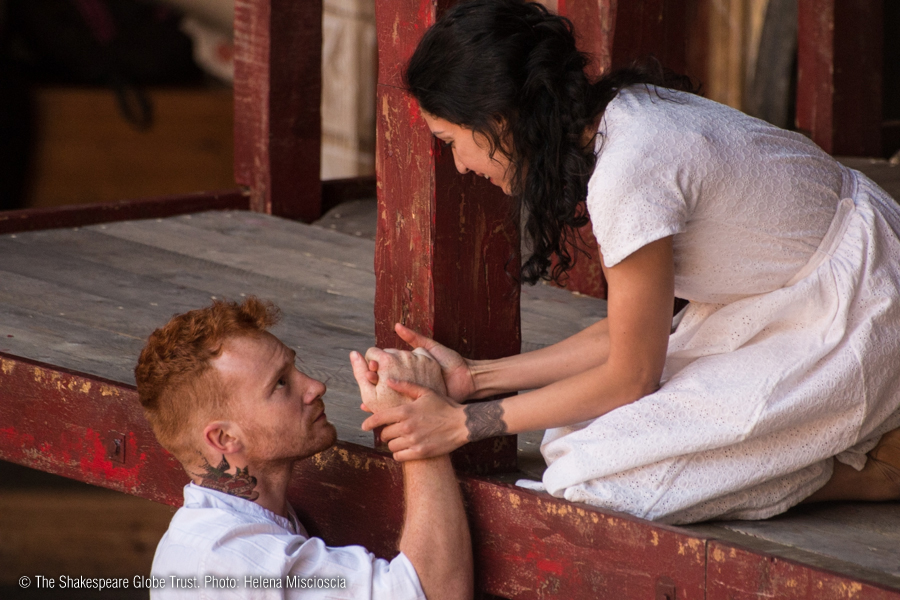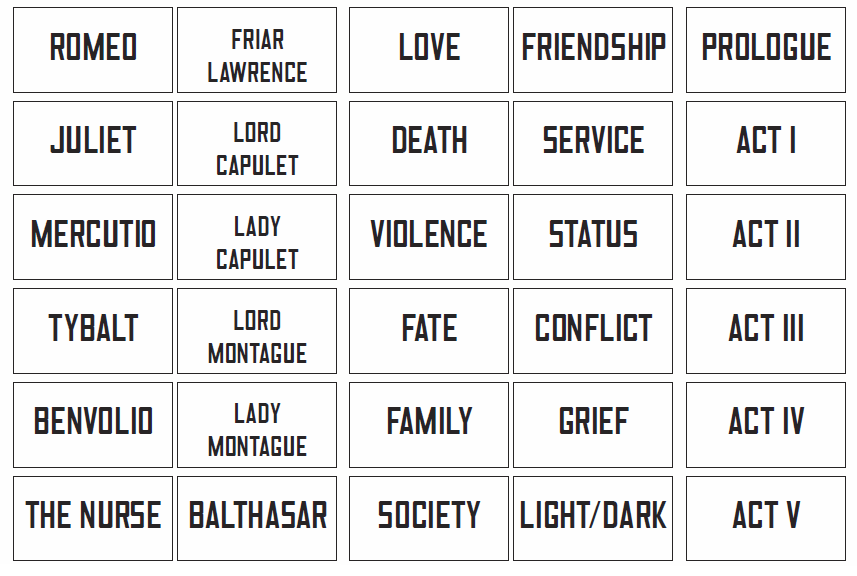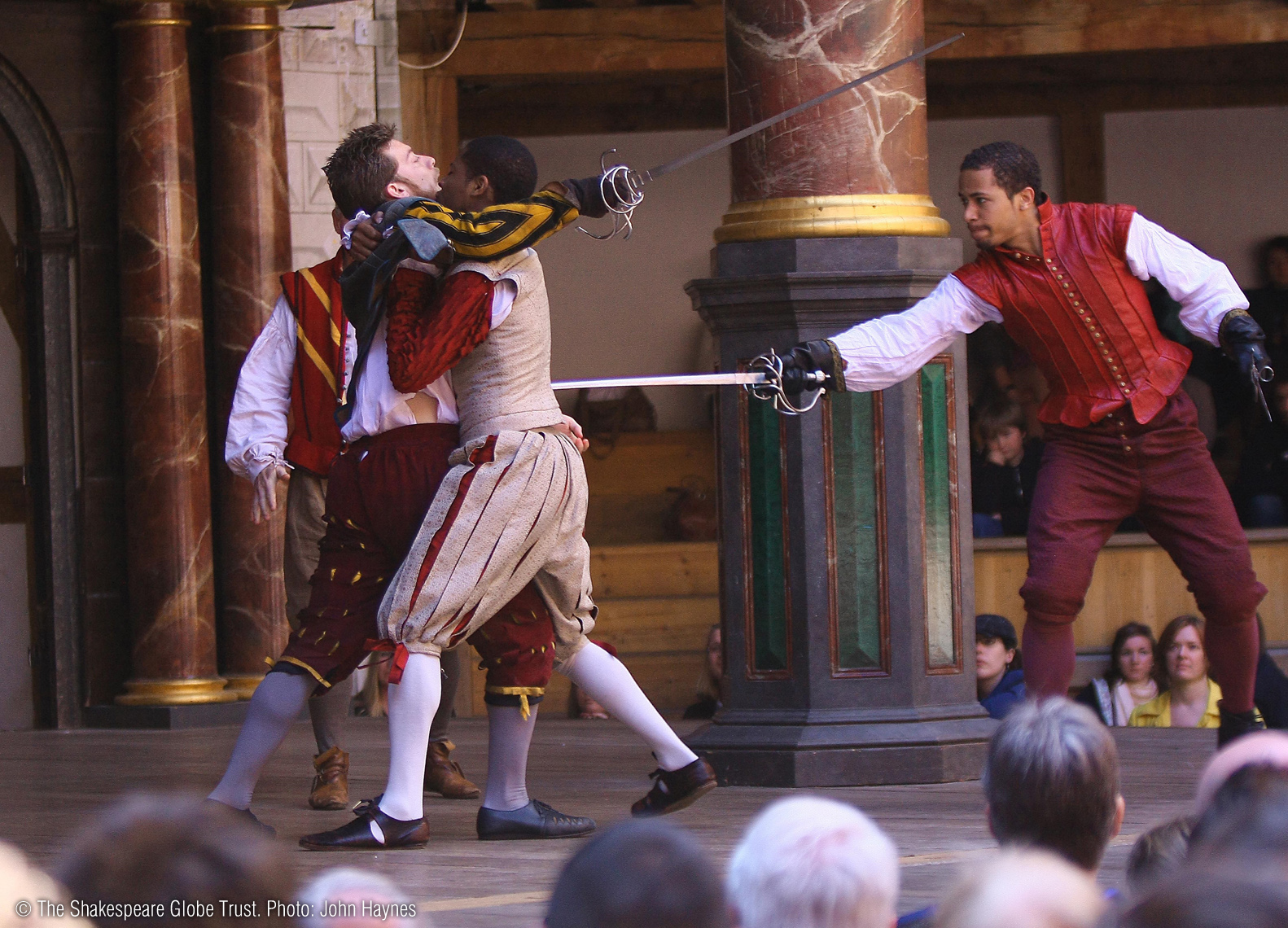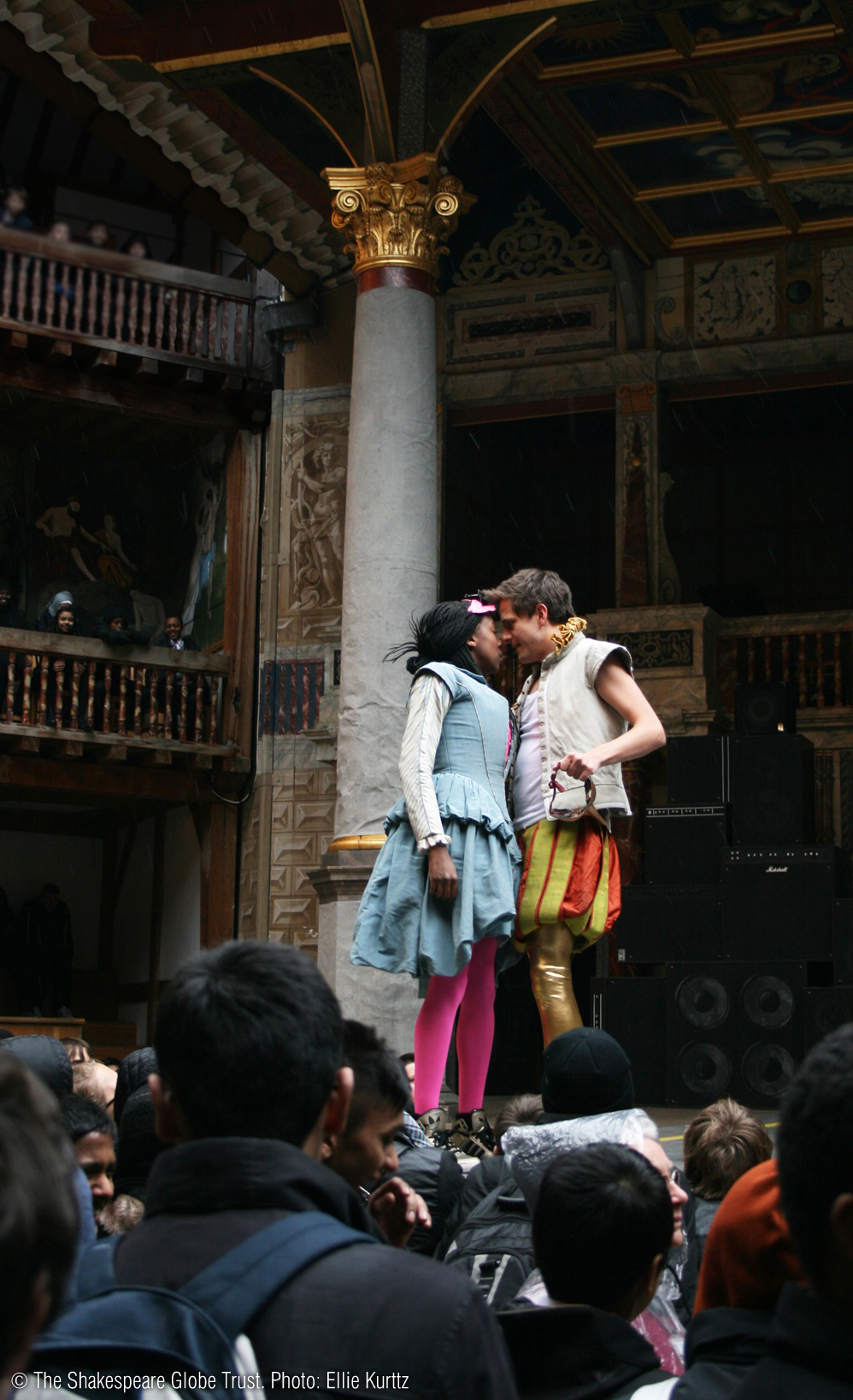In these lessons, students will engage with the themes and ideas at the heart of the text, including fate, love and violence. Tasks include: a close reading of Romeo and Juliet's sonnet in Act 1 Scene 5; exploring the idea of words as weapons and how characters like Tybalt wield them; and a card game which will help connect themes to characters and the text.
In order to benefit fully from these lesson plans, we recommend you use them in the following order:
If students are new to the play, we suggest you start with these introductory KS3 Lesson Plans. If you would like to teach the play in greater detail, use the advanced KS4/5 Lesson Plans.
These lesson plans are available in the Downloads section at the bottom of this page. To download resources, you must be logged in. Sign up for free to access this and other exclusive features. Activities mentioned in these resources are available in a separate downloadable 'Student Booklet', also at the bottom of this page. The 'Teachers' Guide' download explains how best to use Teach Shakespeare and also contains a bibliography and appendices referencing the resources used throughout.
Key Questions for Student:
Can I explain what is meant by ‘theme’?
Can I list some of the key themes of Romeo and Juliet?
Key words: beauty, concealment, conflict, death, fate, family, friendship, love, secrecy, symbolism, theme, truth
Prologue: Opening Discussion
Display the ‘Props’ PowerPoint, which shows a montage of images connected to the plot of Romeo and Juliet. This is available in the Downloads section at the bottom of this page. Students should first of all identify as many items as they can from the montage (e.g. heart, rose, dagger, vial of poison). They should then pick out as many ideas, themes and issues as they that are suggested by the images (e.g. love, violence, war).
Enter the Players: Group Tasks
1) Theme statues
Students are given pieces of paper which represent plaques for statues. They should write down the key themes of the play on these plaques, e.g. conflict, family, love, fate, time, beauty, death, friendship, etc. Imagine that Prince Escalus wants to erect statues around Verona for citizens to look at and learn from. Students should work in pairs or threes to sculpt themselves into thematic statues. Which statues would Prince Escalus choose? You could play the role of Escalus, selecting the statues and justifying ‘his’ choices. As an extension activity, students could embellish the plaques by having an appropriate quotation from the play engraved onto each plaque. There is a page to create some theme ‘plaques’ in the Student Booklet.
2) Text detectives: beauty and love at first sight
Romeo frequently comments on Juliet’s beauty. Explore with students Romeo’s first words when he sets eyes on Juliet, which can be found in the Student Booklet:
ROMEO: [to a Servingman]
What lady’s that which doth enrich the hand
Of yonder knight?
SERVINGMAN: I know not, sir.
ROMEO: O, she doth teach the torches to burn bright.
It seems she hangs upon the cheek of night
As a rich jewel in an Ethiop’s ear,
Beauty too rich for use, for earth too dear.
So shows a snowy dove trooping with crows
As yonder lady o’er her fellow shows.
The measure done, I’ll watch her place of stand
And, touching hers, make blessed my rude hand.
Did my heart love till now? Forswear it, sight,
For I ne’er saw true beauty till this night.

Discussion points include:
- the immediacy and drama of Romeo’s reaction to seeing Juliet
- imagery of riches, jewels, etc.
- references to the sense of touch as well as the sense of sight
- the effect of Romeo’s use of rhyming couplets
- the idea that Juliet’s beauty is superior to all others
- how Romeo’s ‘love’ for Rosaline is eclipsed by Juliet, as seen in the last rhyming couplet
Now ask students to look for more quotations where Juliet’s beauty is described by Romeo. You could use an online concordance to begin with and search for the word ‘beauty’. You could also focus on scenes of courtship, such as Act 1 Scene 5 and Act 2 Scene 2. Also look at how Juliet praises Romeo and describes her attraction to him.
3) Pick a card...
Themes are important throughout a work of literature. To be able to write well about a theme in Romeo and Juliet, students need to track its importance at different points in the play. Have students randomly select a card from each pile: a character, a theme, and a section of the play. The template for these cards can be found in the downloadable Lesson Plans at the bottom of this page. This game could be used in the following ways:
- to support students in becoming more familiar with the play, and in moving more confidently around it and making quick connections
- as a revision tool without the text
- as the basis for detailed small group discussion involving close analysis of a specific passage, through the lenses of particular characters and themes
- to prepare students for exam questions which ask them to write about one part of the play in the context of the whole text

Exeunt: Closing Questions for Students
What would I say are the main themes in the Romeo and Juliet?
What kinds of connections can I make between these themes?
How might a director draw out these themes on stage?
Suggested plenary activity…
In small groups, prepare a performance of the Prologue to Romeo and Juliet accompanied by actions. How many of the play’s themes can students include in their performance?
Asides: Further Resources
- Students could make Valentine’s cards or love letters for Rosaline and Juliet, in the character of Romeo. Use some of Romeo’s quotations about attraction and beauty, and make a display of them. How do Romeo’s feelings for the two women compare?
- Students could also research the theme of beauty in other plays by Shakespeare.
Epilogue: Teacher's Note
Each of the themes mentioned in this suggested learning sequence has a dedicated lesson within these materials. In depth activities linked to ‘Conflict and violence’ and ‘Romantic Love’ follow here within the Key Stage 3 materials. Within the Key Stage 4 materials, there are activities linked to ‘Truth and secrecy, ‘Family’, ‘Age and Time’ and ‘Death, fate and tragedy’. You will also find detailed guidance on writing about themes.
Key Questions for Students:
Can I investigate how Shakespeare establishes and develops the themes of conflict and violence in Romeo and Juliet?
Key words: action, conflict, cue script, feud, insults, mindmap, opposites, prologue, reaction, theme, violence, war, weapons
Prologue: Opening Discussion
In fan fiction, people create their own stories based on characters and locations from a well-known fictional world. Stories set at Hogwarts or in Middle Earth are popular examples! Give students a few minutes to brainstorm ideas about how they think the feud between the Capulets and Montagues might have started and share ideas.
Enter the Players: Group Tasks
1) Insult generator
The Student Booklet provides students with copies of Rex Gibson’s Insult generator, from p. 199 of his book Teaching Shakespeare. Students could warm up by producing single insults and if they have time, they could prepare and rehearse a brief dialogue. Remind students that all the insults are Shakespeare’s. Can they identify which ones come from Romeo and Juliet?
2) Words as weapons
This particular version of this activity was devised by Bill Buckhurst when he was directing Romeo and Juliet in 2008 at the Globe. Pairs of students label themselves A and B and stand facing each other, so that all students are arranged in two lines. They pretend to send a weapon to their ‘enemy’, possibly adding a sound effect. Students take it in turns to hurl imaginary weapons - and to react to the weapons that hit or miss them - for no more than a minute. Students could then apply this technique to a piece of text and to the character who is most vocal in that conflict, e.g. Tybalt in Act 3 Scene 1. Assign a line from this character to each student, and then ask the students to identify the most hurtful or damaging word in that line. Students should now hurl that word to their opponent and vice versa. Discuss afterwards which words were the most effective weapons and why.

3) The brawl: working with a cue script
Sitting in groups of nine, students should be assigned a character from Act 3 Scene 1. They should also be given a ‘cue script’ for that part. This consists of only the lines that character speaks (in the order in which they are spoken), and the three cue words spoken by another character before each of their lines. students could even construct their own cue scripts using an online version of the play text that they can cut and paste as needed. Students should work together – without a director - to develop their understanding of and confidence with this scene. Every time they read their lines they should think more about how they should speak, how they should move and why, using the clues in the text itself.
Exeunt: Closing Questions for Students
To what extent is Romeo and Juliet a play about conflict and its consequences?
How would you present the conflict in the play to audiences?
Which non-violent scenes contain conflict?
Can all of the violence of the play be explained by the conflict between the Montagues and the Capulets, or are there other causes?
Suggested plenary activity…
Students should create a colourful, illustrated mindmap with the word ‘conflict’ or ‘violence’ in the middle. As they read the play, they should add ideas relating the ideas of conflict and violence to the play’s characters, their situations and problems, their relationships and their motivations.
Aside: Further Resource
- At the time Shakespeare was writing Romeo and Juliet, England was divided following Henry VIII’s split from the Catholic Church in 1533. Bitter feuding between Protestants and Catholics would have been an everyday reality for young men like Shakespeare.
Epilogue: Teacher's Note
Students could develop their ideas about how the feud began into a piece of creative writing.
Key Questions for Students:
Can I investigate how Shakespeare establishes and develops the theme of romantic love in Romeo and Juliet?
Key words: imagery, marriage, motifs, passion, romantic love, sonnet, staging, storyboard, tragic, youth
Prologue: Opening Discussion
The video to Des’ree’s ‘Kissing You’ song from Baz Lurhmann’s Romeo + Juliet could be playing as students enter the classroom for a lesson on this topic. Students could make a note of motifs and symbols that are associated with love in the video. Take feedback.
Enter the Players: Group Tasks
1) Text detectives: Romeo and Juliet’s sonnet
Elicit from students what they already know about the sonnet form: its length, iambic pentameter, rhyme scheme, association with love, Shakespeare’s own famous sonnet sequence. Explore closely the first words Romeo and Juliet exchange with each other in Act 1 Scene 5 lines 92-109, which can be found in the Student Booklet:
ROMEO: If I profane with my unworthiest hand
This holy shrine, the gentle sin is this:
My lips, two blushing pilgrims, ready stand
To smooth that rough touch with a tender kiss.
JULIET: Good pilgrim, you do wrong your hand too much,
Which mannerly devotion shows in this,
For saints have hands that pilgrims’ hands do touch,
And palm to palm is holy palmers’ kiss.
ROMEO: Have not saints lips and holy palmers too?
JULIET: Ay, pilgrim, lips that they must use in prayer.
ROMEO: O then, dear saint, let lips do what hands do –
They pray; grant thou, lest faith turn to despair.
JULIET: Saints do not move, though grant for prayers’ sake.
ROMEO: Then move not while my prayer’s effect I take.
Give me my sin again. [Kisses her.]
JULIET: You kiss by th’ book.
Students could annotate these lines. Support them in their note taking, so that the following structural and language features are drawn in the discussion:
- the 14 line structure
- the rhyme scheme (ABABCBCBDEDEFF)
- religious imagery such as ‘pilgrims’, ‘saints’ and ‘sin’
- the physicality of the language (‘lips’, ‘hands’, ‘touch’)
- repeated words such as ‘prayer’, ‘hand’/’hands’ and ‘palm’/’palmers’
- the poem’s conclusion with a rhyming couplet and a kiss
Discuss with students the effect of Romeo and Juliet’s first words together forming a sonnet.

(Students could also watch footage of this sonnet in the link below, as performed by Jade Anouka and Will Featherstone.)
2) Staging the balcony scene
As an introduction to this task, students could watch this scene in the Zeffirelli and/or the Lurhmann version. Take some brief feedback from students about what they have noticed and what they enjoyed. Then watch the footage of this scene below from the 2013 Globe production, starring Will Featherstone and Jade Anouka. Students could make notes in the Student Booklet about different ways in which the scene has been staged, how it could be staged, and the effects of different choices.
3) Marriage
In Act 3 Scene 5 lines 1-64, Shakespeare presents Romeo and Juliet’s short-lived happiness together as a married couple. Students could then discuss their own ideas about staging this scene and the effect they want this scene to have on the audience. Students should create either a storyboard with speech bubbles for quotations, or an annotated script to indicate their ideas about directing this scene. Students can draw on interests in drawing, collage, photography, dance, etc. to develop their personal responses to this task. There is a page for students on writing a commentary linked to their storyboards in the Student Booklet.

(One version of how to stage this scene can be viewed in the link below. Students could compare this with the version from the Globe DVD and/or from other film versions too).
Exeunt: Closing Questions for Students
How does Shakespeare convey the intensity and sincerity of Romeo and Juliet’s love for each other?
What are the factors that prevent Romeo and Juliet’s love story from having a happy ending?
Suggested plenary activity…
In Shakespeare’s comic play A Midsummer Night’s Dream– written at around the same time as Romeo and Juliet, and seen by many as a companion play to it – Lysander says ‘The course of true love never did run smooth’. Discuss the truth of this quotation in relation to Romeo and Juliet and, if students are sufficiently familiar with it, to A Midsummer Night’s Dream too. What do the two plays have in common?
Asides: Further Resources
- Shakespeare and his contemporaries often wrote action for the upper level of the stage. The use of the upper level in this scene means that Juliet is both safe at home and at the same time visible to Romeo, allowing for an extended moment of intimacy.
- The word ‘balcony’ might have been unknown to Shakespeare. Our first record of it in writing dates from two years after the play was written. Although Shakespeare says that Juliet appears ‘aloft’, the convention of Juliet appearing on a balcony only became commonplace after David Garrick used a balcony in his adaptation in the eighteenth century.
Epilogue: Teacher's Note
The storyboard/annotated script activity on Act 3 Scene 5 lines 1-64 could be accompanied by a commentary and used as an assessment piece.
